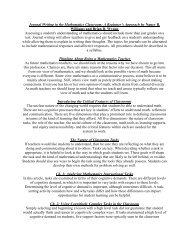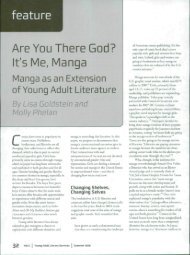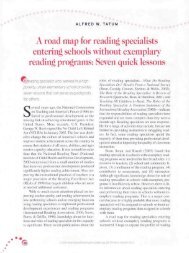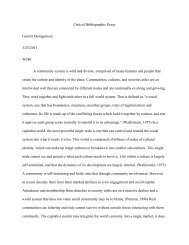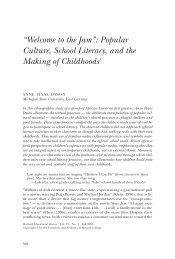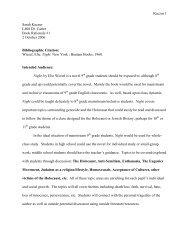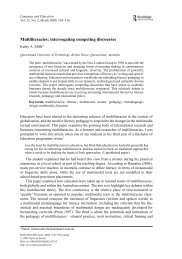Kaczur 1 Sarah Kaczur L408 Dr. Carter Book Rationale ... - Oncourse
Kaczur 1 Sarah Kaczur L408 Dr. Carter Book Rationale ... - Oncourse
Kaczur 1 Sarah Kaczur L408 Dr. Carter Book Rationale ... - Oncourse
Create successful ePaper yourself
Turn your PDF publications into a flip-book with our unique Google optimized e-Paper software.
<strong>Kaczur</strong> 21Anderson, and Hard Love by Ellen Wittlinger. What do these books have in common that makethem unusual and outstanding examples of young adult literature? They are structurallysophisticated, and they have memorable characters who deal with significant issues. Thesesignificant issues or themes sometimes overlap. Monster, Speak, and Hard Love deal with thesearch for identity; Skellig, Speak, and Hard Love explore friendship; and all four novelsexamine facets of truth.MonsterAs is frequently the case with young adult literature, the protagonist of each novel is alsothe first person narrator. In Monster, sixteen-year-old Steve Harmon, who is on trial for murder,analyzes his part in a robbery that results in a storekeeper's death. He seeks to determine who heis-a monster, as the prosecutor labels him and as the title reflects- or a human being. He hastaken a film class in high school and contends with the pressures of the trial and incarceration bypretending to film the courtroom events. He has also been given a notebook which serves him asa journal. In this he writes:I can hardly think about the movie, I hate this place so much. But if I didn't think of the movie Iwould go crazy. All they talk about in here is hurting people. If you look at somebody, they say,"What you looking at me for? I'll mess you up!" ...I hate this place. I hate this place. I can't write it enough times to make it look the way I feel. Ihate, hate, hate this place!! (Monster, 45-46)In his cell he is constantly afraid, and in the courtroom he is constantly afraid. This feardistorts reality, and the supposed filmmaking and the journal help Steve to cope. The film servesa second purpose as well. Although Steve conveys events in his own voice, he describes thescenes in the courtroom from different distances - closeup, middle, or long range - and fromdifferent participants' points of view through snippets of dialogue.When presenting the award, Bradburn observed, "The detached style of the screen play,juxtaposed with the anguished journal entries, reveals the struggle within Steve's conscience"(ALA, Walter Dean Myers). In addition, the multiplicity of views given through the snippets ofdialogue forces the reader to examine Steve's role in the crime and the extent of his guilt.In the case of Monster, format contributes to structure and theme. The cover of the bookreplicates a police record, which includes fingerprints, and the book jacket bears a mug shot.Once the reader opens the book, he or she sees that the courtroom scenes are in typical type onwhite paper whereas the journal entries appear to be printed by hand on gray paper. Thesedifferences reinforce the sense of distance and intimacy as well as take the reader from the worldof the courtroom where clear distinctions are made into the world of the mind where truth andfear blend to create a gray reality.




